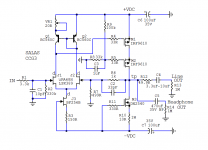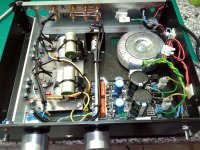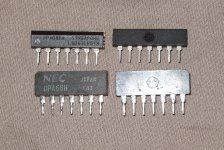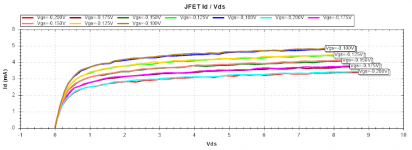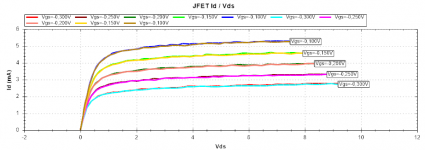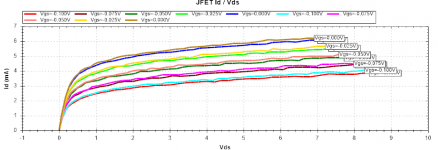I had question about using 2SK389-V Toshiba. Answer is yes it will work. J3 (with R3 as degeneration) fixes the JFET LTP total current at about 5mA so the IDSS of the monolithic chip won't matter as long as it is >3mA tested per element. What will happen is THD will go 0.00025% but the flat trend will go rising trend. I know because I have tested K170BL and V matched pairs. LSK389 does not go such so much because it has less pF. I have tested that too. Its elements curve matching is visibly worse than uPA though. The NEC behaves closer to 2SK117. Pins order is compatible to Toshiba 2SK389. Don't connect the sub pin to anything or it will hum.
Attachments
Far more easier. Forgotten part by DIY. I got mine from ebay. There are fat and slim ones. Will take picture for you.
Any good/recommended source for the NEC parts?
Anything HK based with top seller badge will do
He has only got test ones to make his preamp for now. When it will be fully boxed up I will do final system overview so I reserve for possible practical layout changes.
My DCG3 Experience
Hi All, I am really grateful to Salas for including me as a beta tester for DCG3 project.
I started sometime early June when I received the schematic. With a lot of help (and patience) from Salas, I have managed to put together my working DCG3 prototype and has been tweaking/listening to it the last month.
Let me state upfront that this is my most eagerly anticipated DIY project. I set out to build it double mono, power it with V1.2 main rail and with LDR volumn control, the result is a great sounding and most satisfying preamp in my system.
Let me attempt to describe how it sounds (subjectively in the context of my all DIY system); compared to my last preamp which is based on a famous buffer stage/LDR attenuation/V1.2 psu, it sounded faster, equal to if not more transparent, has better resolution, more detailed, better tone and image density, and exhibit tight control when the music gets complicated.
I strongly recommend everyone here to try this out in your system.
Hi All, I am really grateful to Salas for including me as a beta tester for DCG3 project.
I started sometime early June when I received the schematic. With a lot of help (and patience) from Salas, I have managed to put together my working DCG3 prototype and has been tweaking/listening to it the last month.
Let me state upfront that this is my most eagerly anticipated DIY project. I set out to build it double mono, power it with V1.2 main rail and with LDR volumn control, the result is a great sounding and most satisfying preamp in my system.
Let me attempt to describe how it sounds (subjectively in the context of my all DIY system); compared to my last preamp which is based on a famous buffer stage/LDR attenuation/V1.2 psu, it sounded faster, equal to if not more transparent, has better resolution, more detailed, better tone and image density, and exhibit tight control when the music gets complicated.
I strongly recommend everyone here to try this out in your system.
What is the purpose of the second hexfet (M2)?
it's a cascode device, so that M1 sees a near constant drain-source voltage, to reduce distortion.
as to how it achieves that exactly is a bit beyond me though....
Last edited:
- Home
- Source & Line
- Analog Line Level
- Salas DCG3 preamp (line & headphone)
